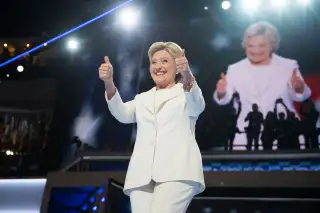Trump Beat Clinton in the TV Ratings Battle. Does That Mean He'll Win the Election?

The Democratic National Convention won the TV ratings war for the first three nights, but the Republicans came out ahead on the final evening, when Donald Trump spoke. What does this tell us about who will become president? Not as much as you might think.
Democrat Hillary Clinton attracted 29.8 million viewers for the convention finale on Thursday, Nielsen ratings numbers show. But Trump had 32.2 million viewers for his last night, a week earlier. When Trump gave his address July 21, the Republicans’ TV ratings shot up by a third from the night before.
Democrats since 1960 — which many consider the dawn of the televised presidential contest — through 2012 were the convention ratings winners in 10 of the 14 White House races. When it came to actually capturing the presidency, though, the parties split, seven to seven.
But let’s look at the last two times there was an open seat, which is the case this year. (This means the incumbent has served his two terms and can’t run again.)
In 2000, the Democrats' convention was the TV audience champ by 15.3 to 13.9, according to the Nielsen, representing households watching the party shows during prime time. Still, Republican George W. Bush defeated Al Gore that fall, albeit narrowly. In 2008, the Republican convention was the leader on the tube, 21.9 to 19.9. Then Democrat Barack Obama handily outpaced John McCain in the November election.
The 2016 conventions are somewhat unusual in that both nominees are well-known, notes Zachary Karabell, a political scientist who has studied TV in politics and is head of global strategy for financial consulting firm Envestnet. Indeed, the primary-season debates were fiery affairs that made for good television, particularly the Republican ones, thanks to Trump’s outsized presence. Suddenly, the debates were transformed from droning civics lessons into smack downs.
A key point, however, is that people who watch political conventions are “a small subset of the human race,” Karabell says, namely committed partisans. “The conventions serve more as party galvanizing events.” How this ends up playing with the general electorate is a big unknown.
“It’s safe to day the ratings have no electoral meaning,” according to Larry Sabato, director of the University of Virginia’s Center for Politics. And their convention viewership often is linked to dramatic appeal that may be irrelevant to voters’ preferences.
In 1968, when Democrats lost the election, their convention attracted the highest ratings because of dissension on the floor between pro- and anti-war forces and rioting outside the arena. Although it was “a giant fiasco,” Sabato wrote on his website, “the massive protests undoubtedly made for gripping television.”
In 1976, the GOP had a contested gathering, as President Gerald Ford fought off Ronald Reagan’s effort to displace him as the nominee. The Republican event had 25% higher viewership than did the Democrats, as people tuned in to watch the spectacle. Yet Jimmy Carter went on to secure the Oval Office for the Democrats.
In 2008, by Sabato's reckoning, curiosity over the debut of McCain’s running mate, Sarah Palin, made her appearance a big hit, which lifted the Republican convention’s overall viewership ahead of the Democrats’ showing—but failed to translate into a November victory.
Critics deride conventions nowadays, when the nominee is pre-ordained, as mere party infomercials. They certainly aren’t crystal balls.